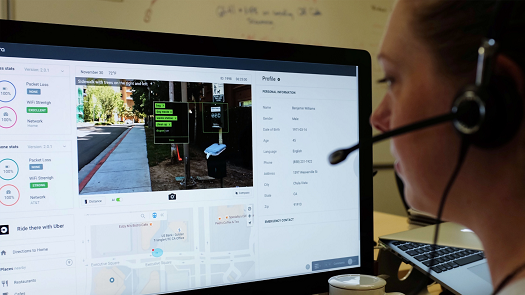What Are Magic Glasses?
Show of hands or better yet, clap if you like to make fundamental changes in the way you do everyday, daily living activities! Are you one of those folks who relish the idea of throwing away the computer mouse and trackpad to rely solely on keyboard shortcuts to do your work? Or suddenly read your favorite books and magazines by listening to them? Abandon your usual mode of transportation and just switch to Uber, public transportation, or a bicycle? A couple of you are clapping, but the rest of us recognize these changes will be time-consuming and inconvenient at best. Even the most adventuresome of us may find some of these fundamental changes in our lifestyle can be disorienting, have a negative impact on doing routine tasks, and be anxiety-provoking until we learn other ways to accomplish what used to be everyday activities.
More than one vision rehabilitation therapist has used the term "magic glasses" to describe the as-yet-unavailable procedure, technology, or optical device that will reverse an individual’s vision loss. In this era of high technology and miracle drugs and cures, it is hard to imagine that there is not some procedure, optical refraction, implant, or drug that will correct or reverse vision loss from macular degeneration, glaucoma, diabetic retinopathy, and other causes of vision loss! "Magic glasses" is a metaphor to describe the fast or easy solution to returning to a world that we understood, with the ability to recognize familiar faces across the room, drive independently from here to there, see the mouse arrow on the computer screen, and all the other visual daily activities often just taken for granted.
Magic Glasses and Assistive Technology
The notion of the "magic glasses" has taken on new meaning in the past several years in the world of assistive technology (AT). Glasses are becoming an integral part of some of this technology. Glasses are now being used to mount miniature video cameras, converted into wearable computer displays, or both. The integration of this technology to glasses has led to them being referred to as "smart glasses."

Two of the most popular smart glasses include the Aira (pronounced eye-ra) glasses and the OrCam. Both utilize cameras mounted on the glasses that are connected to a pocket-sized computer about the size of a smartphone. The glasses resemble a regular pair of glasses—only a close look reveals the addition of a small camera. In fact, the OrCam camera and speaker are simply mounted to the arm of a regular pair of glasses. Until relatively recently, OrCam and Aira offered quite different services.
The OrCam
Using hand gestures, the OrCam user has a powerful OCR (optical character recognition) system at their disposal. Users look at text they wish to read, take a picture using a hand gesture, and listen to the text being read back nearly instantaneously. The OrCam can tackle street signs, menus, newsprint, etc. Human faces and favorite products can be saved into the OrCam memory for recall the next time the person or product is seen. The OrCam MyEye 2.0 retails for $4,500.
The Aira
Aira utilizes a video camera mounted on a proprietary pair of glasses. Users summon a human assistant when needed via a high-speed Internet connection. The human assistant remotely sees what the user is looking at and offers assistance as needed. For example, if a user wanted to read the board in an airport showing arriving and departing flights, the Aira assistant might instruct the user to move her head until the board was located then read the information seen through the video camera. The assistant is available for clarification or to provide real-time research, such as look up an airport map to locate the nearest restroom or coffee shop.
Aira offers subscriptions to users based on monthly blocks of usage minutes. Subscriptions start at $89 per month for 100 minutes and also include $129 per month for 200 minutes, $199 for 400 minutes, and $329 per month for unlimited usage. The smart glasses and hardware are all included in the subscription price.

The NuEyes Pro
NuEyes is a head-mounted display that resembles glasses, with a video camera mounted on the front. It appears less discreet than some of the other smart glasses because the "lenses" are opaque. NuEyes also has an OCR built in and a barcode scanner. It differs from both the OrCam and Aira in that it can magnify the image from the video camera up to 12X on the glasses display and add contrast by changing the foreground and background colors, much like you would expect on a video magnifier.
NuEyes is based on an Android operating system that appears to be built into the glasses, as opposed to a separate pocket computer or smartphone, which will certainly make them heavier than either the OrCam or Aira glasses. The advantage, however, is that NuEyes are wireless and don’t need to be cabled to a remote processor, as is the case with the other two.
Are These the New Magic Glasses?
Are these the magic glasses? While this is not a comprehensive list of the glasses being promoted for individuals with vision loss, it is safe to say that none will completely compensate for all the daily life activities that vision loss can impact. On the other hand, there is also no doubt that at least one of the features offered might be a handy or a welcome addition to an assistive technology toolkit. A recent tour of another smart glasses product, not mentioned above, which retails for $10,000 got me thinking. The whole notion of the magic glasses and the vulnerability we may have as consumers for some of these new devices made me pause. On my tour of the eSight website, I was a bit disheartened by the "Moments" link with stories and videos highlighting the first time a child saw his mother or the Easter bunny, wearing the eSight glasses, or the first time a person with an acquired vision loss saw family members "clearly" in decades. I wondered how many of these moments might have also happened with a quality monocular or a desktop video magnifier for a fraction of the cost? As I filled out the form to request more information on how to "Experience eSight: At Home," there were a great number of questions related to how I might potentially pay for the eSight smart glasses. I didn’t gush about my funding options and never received a reply to my request.
It is my hope that our search for the magic smart glasses doesn’t override our savvy as smart consumers to ask practical questions about these devices and take the opportunity to try them in real life situations at work or in the home. Take a little time to research these devices in a reputable journal like the American Foundation for the Blind’s AccessWorld Magazine or consult with a local assistive technology professional or vision rehabilitation therapist who may provide an unbiased assessment and help you develop a strategy for resuming daily living or working activities with or without the "magic glasses."